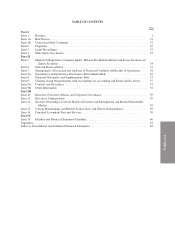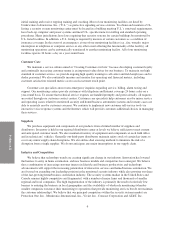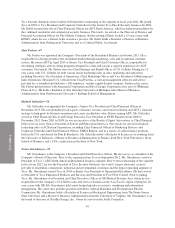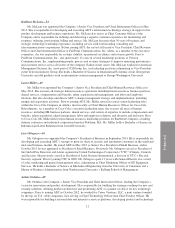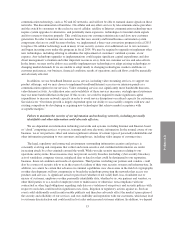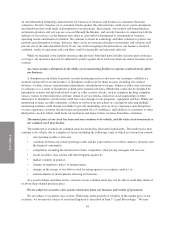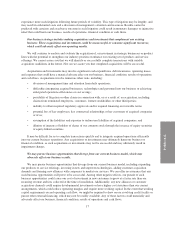ADT 2014 Annual Report Download - page 74
Download and view the complete annual report
Please find page 74 of the 2014 ADT annual report below. You can navigate through the pages in the report by either clicking on the pages listed below, or by using the keyword search tool below to find specific information within the annual report.
FORM 10-K
We also currently rely extensively upon the use of both wireline and wireless telecommunications to
communicate signals, and wireline and wireless telephone companies in the United States are regulated by
federal, state and local governments. The U.S. Federal Communications Commission (“FCC”) and state public
utilities commissions regulate the operation and use of wireless telephone and radio frequencies. Although the
use of wireline phone service has been decreasing, we believe we are well positioned to respond to these trends
with alternate transmission methods that we already employ, including cellular and broadband Internet
technologies. Our advertising and sales practices are regulated by the U.S. Federal Trade Commission (“FTC”)
and state consumer protection laws. In addition, we are subject to certain administrative requirements and laws of
the jurisdictions in which we operate. These laws and regulations may include restrictions on the manner in
which we promote the sale of our security services and require us to provide most purchasers of our services with
three-day or longer rescission rights.
Some local government authorities have adopted or are considering various measures aimed at reducing
false alarms. Such measures include requiring permits for individual alarm systems, revoking such permits
following a specified number of false alarms, imposing fines on customers or alarm monitoring companies for
false alarms, limiting the number of times police will respond to alarms at a particular location after a specified
number of false alarms, requiring additional verification of an alarm signal before the police respond or
providing no response to residential system alarms. See risk factors “We could be assessed penalties for false
alarms” and “Police departments could refuse to respond to calls from monitored security service companies.”
The monitored security industry is also subject to requirements, codes and standards imposed by various
insurance, approval and listing and standards organizations. Depending upon the type of customer, security
service provided and requirements of the applicable local governmental jurisdiction, adherence to the
requirements, codes and standards of such organizations is mandatory in some instances and voluntary in others.
Changes in laws and regulations can affect our operations, both positively and negatively, and impact the
manner in which we conduct our business.
Employees
As of September 26, 2014, we employed approximately 17,500 people. Approximately 12% of our
employees are covered by collective bargaining agreements. We believe that our relations with our employees
and labor unions have generally been good.
Available Information
ADT is required to file annual, quarterly and current reports, proxy statements and other information with
the U.S. Securities and Exchange Commission (“SEC”). Investors may read and copy any document that ADT
files, including this Annual Report on Form 10-K, at the SEC’s Public Reference Room at 100 F Street, N.E.,
Room 1580, Washington, DC 20549. Investors may obtain information on the operation of the Public Reference
Room by calling the SEC at 1-800-SEC-0330. In addition, the SEC maintains an Internet site at www.sec.gov
that contains reports, proxy and information statements and other information regarding issuers that file
electronically with the SEC, from which investors can electronically access ADT’s SEC filings.
We maintain a web site at www.adt.com. We make available free of charge on or through our web site our
Annual Reports on Form 10-K, Quarterly Reports on Form 10-Q, Current Reports on Form 8-K, reports filed
pursuant to Section 16 and any amendments to those reports filed or furnished pursuant to Section 13(a) or 15(d)
of the Securities Exchange Act of 1934, as amended (the “Exchange Act”), as soon as reasonably practicable
after we electronically file or furnish such materials to the SEC. In addition, we have posted the charters for our
Audit Committee, Compensation Committee, and Nominating and Governance Committee, as well as our Board
Governance Principles and Code of Conduct, on our web site under the heading “Corporate Governance.”
8



